Yadier Molina’s Strong Start Seems Meaningful
In the war for the NL Central, the Cardinals are leading the charge. Their robust 25-18 record is no stroke of luck – per our BaseRuns standings, they’ve outperformed their theoretical win total by just one. Breaking this down further, the pitching has done most of the heavy lifting. Jack Flaherty has become that ace who’s going to ace, Kwang Hyun Kim has upped his strikeout rate thanks to a refined slider, and John Gant (!) has a 2.08 ERA in 39.2 innings. Gant is also leading major league baseball with 28 walks, but hey, the Cardinals will take it.
The offense isn’t bad – it has managed 4.29 runs per game, which is about the league average. It might have been worse, however, if not for Yadier Molina. The legendary catcher somehow has a 138 wRC+, the second-highest amongst Cardinals hitters with at least 50 plate appearances. His defense is no longer an asset, but he’s more than made up for lost value by swinging a hot bat.
But sure, this isn’t the first time Molina has gone on an offensive tear. Looking at 25-game stretches of wOBA dating back to 2018, we can see the many peaks and valleys that have shaped his production:

There are three clear maxima. The first occurred in July 2018, the second in September 2019, and the most relevant one falls in between April and May of this year. So what’s different about Molina’s current rendition? To find out, I looked at his Statcast data from rough one-month windows corresponding to those peaks. Here they are organized in a table:
| Time Frame | HardHit% | Barrel% | xwOBA |
|---|---|---|---|
| 7/1/18 – 7/31/18 | 37.7% | 5.2% | 0.341 |
| 9/1/19 – 9/30/19 | 42.0% | 2.5% | 0.343 |
| 4/19/21 – 5/19/21 | 38.5% | 10.3% | 0.336 |
A common trait is the prevalence of hard-hit rate. Hitting the ball hard is good! We here at FanGraphs embrace it. What is a newfound skill of Molina’s, however, is his Barrel rate – for the first time in a long while, he’s not only striking balls hard but also elevating them. When I wrote about teammate Matt Carpenter back in April, I noted that a majority of hitters tended to preserve some of their early-season Barrel rates. Though the danger of a small samples always looms, this might be a positive sign for Molina.
I’m not the first person to notice this, of course. Over at Viva El Birdos, Blake Newberry drew most of the same conclusions in a succinct manner. But digging through various articles for research – and correct me if I’m wrong – I didn’t see one point out the other change Molina has made. There’s been a good number of plate appearances now, and it seems like he’s altered his swing. For example, here’s a pair of screenshots that were taken as the pitcher reached the height of his windup. On the left is last season, and on the right is this season:
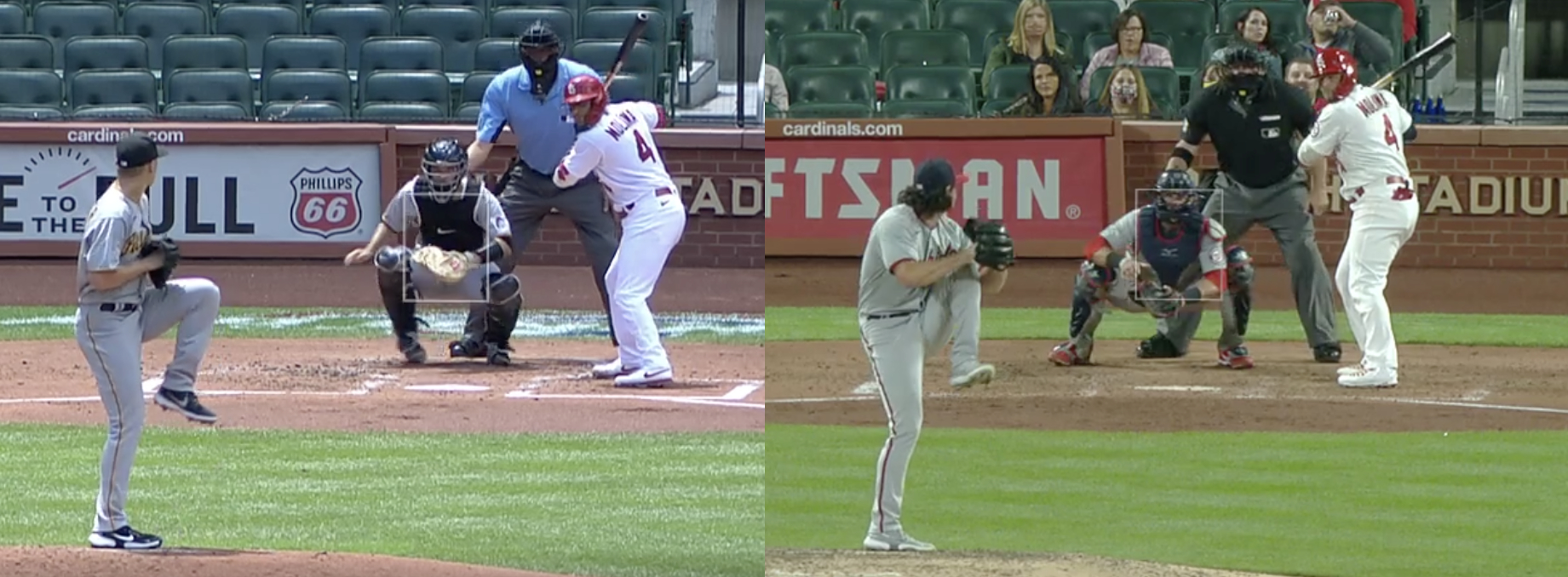
This isn’t a case where you have to squint – the difference is right there. Molina now assumes a more upright posture, with the bat resting on his shoulder instead of dangling in the air. Both instances took place on a 2-2 count, but the new Molina seems relaxed, even with two strikes. The next screenshots are also interesting:
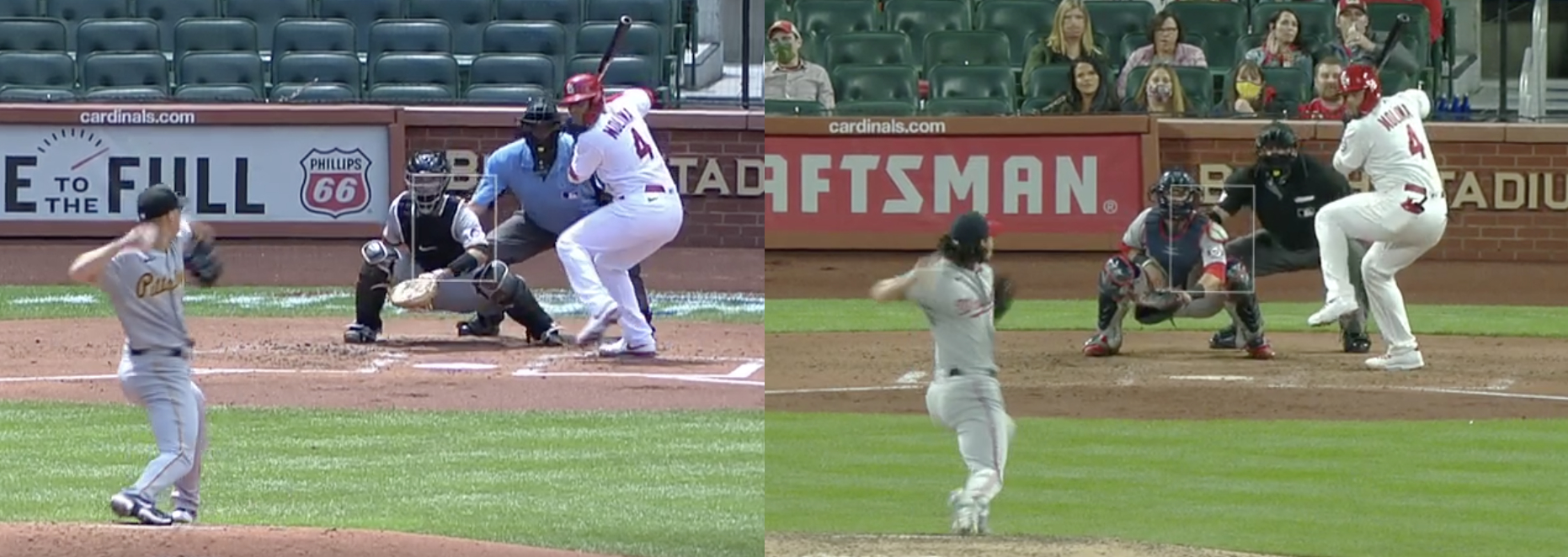
Maybe this is a matter of when I captured it, but Molina’s leg kick on the right is more exaggerated, Justin Turner style. I’d imagine that this combined with an upright posture allows Molina to achieve a smoother transfer of power from the hips to the torso – with his former mechanics, there’s more lingering around in search of contact. Finally, here’s what happens at the moment of contact:
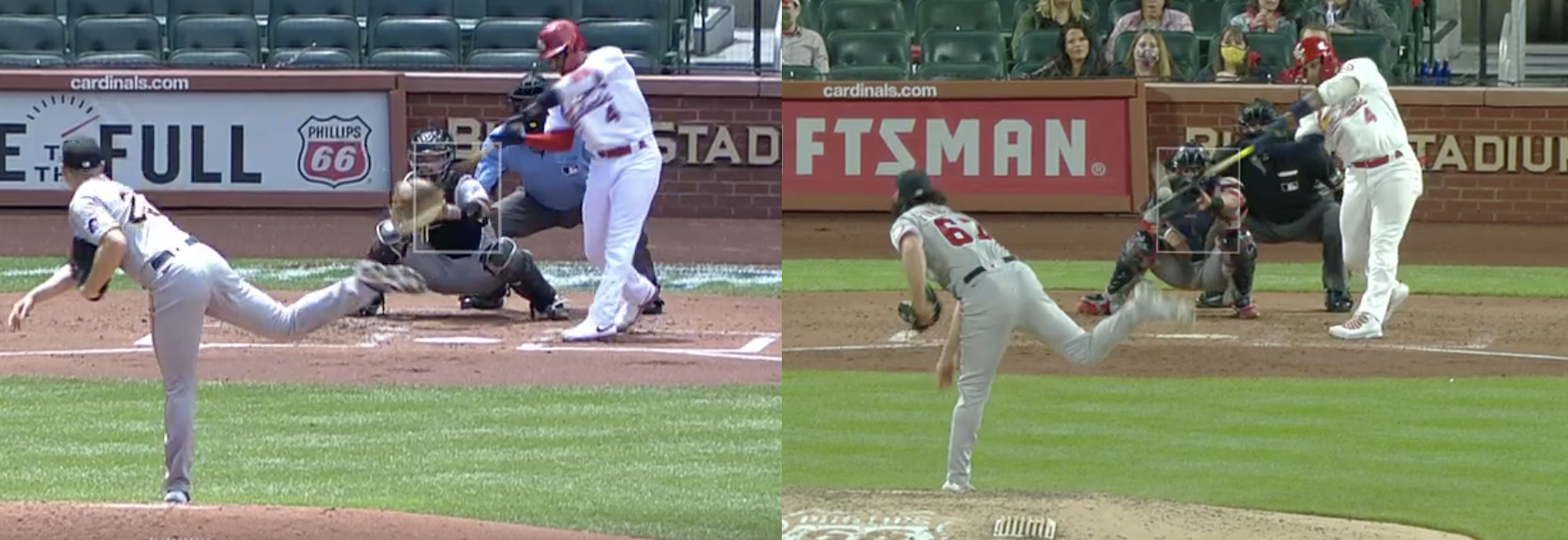
The number on Molina’s jersey acts as a cue. Notice how it’s facing outwards in the screenshot from this season, suggesting that his body is more out in front than before. And overall, it makes sense how he’s achieving greater loft. The pitches thrown to both versions of Molina were sinkers of similar velocity, landing on the outer edge of the zone. Last year, he grounded into a double play. But this year’s Yadi is a bit different, and he deposited a baseball into right field for a home run:
These examples are cherry-picked by definition, but only because I have to! It’s also good to control for things like the camera angle and pitch location. Sift through other clips of Molina hitting this year, and you’ll still encounter the aforementioned changes.
Swinging for the fences isn’t without its drawbacks. Big hacks come with big misses, and Molina’s current strikeout rate of 22.2% is the highest of his career by a significant margin. In his article, Newberry cited a career high in swing rate (58%) and a second high in first-pitch swing rate (44.4%). But when looking at Molina’s swing rates when he’s ahead, behind, or even in the count, it didn’t seem like his approach had been altered in any specific way — the swings are up across the board, so there’s no selective aggression taking place. But when we consult Molina’s whiff rates by count type, the abundance of strikeouts isn’t too surprising:
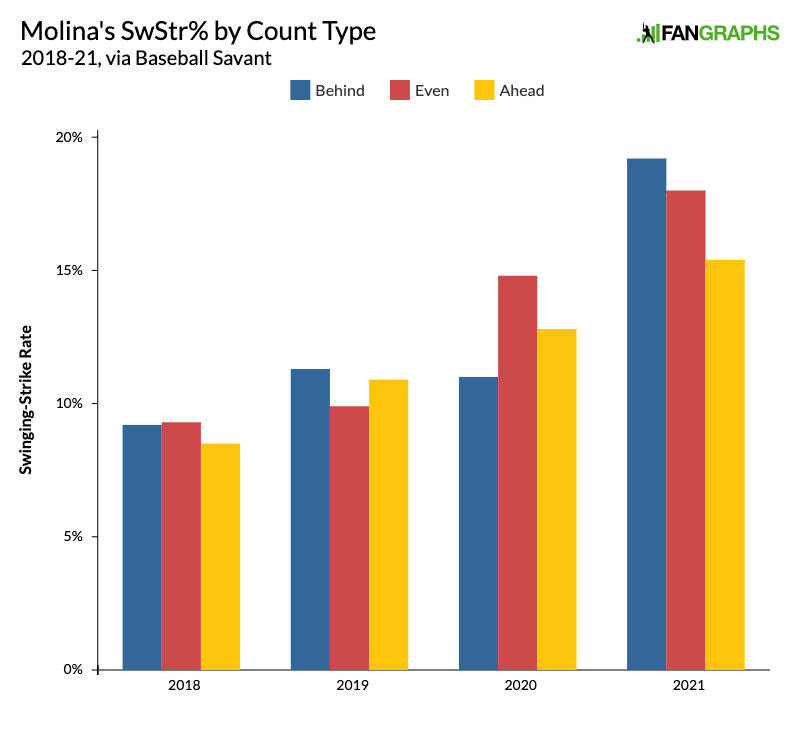
The veteran catcher is whiffing more frequently regardless of the count, but it’s telling that ones in which he’s behind accounts for a large portion of the uptick. Falling behind puts hitters at a massive disadvantage, and Molina’s new swing is perhaps unsuited for escaping such situations. What’s worse, it seems like pitchers have caught onto this and are adjusting how they pitch to Molina. Consider this: They’re throwing strikes to Yadi 60% of the time on 0-0 counts, the highest rate against him in the Statcast era. After arriving at 0-1, they switch gears and throw strikes just 39.4% of the time, the lowest rate against him in the Statcast era.
The strategy is fairly simple. By making sure the first pitch is a strike, you place Molina into a corner as fast as possible. And since he’s whiffing often when behind, there’s less pressure to locate over the plate — if anything, a buried breaking ball might get better results.
That doesn’t mean Molina is at the plate like a sitting (standing?) duck, though. With two strikes, he’s often elected to shorten the leg kick. And when he’s confident about a pitch — the oppo bomb was hit on a 2-2 count, remember — the full-on swing returns. In sum, added vulnerability in difficult counts isn’t a dealbreaker but could exacerbate Molina’s weaknesses, especially when he’s slumping or isn’t feeling completely himself. Indeed, after a right foot tendon strain on April 27th that placed him on the injured list, the veteran’s production has been trending downward. Here’s the rolling wOBA graph again, this time in 15-game partitions:
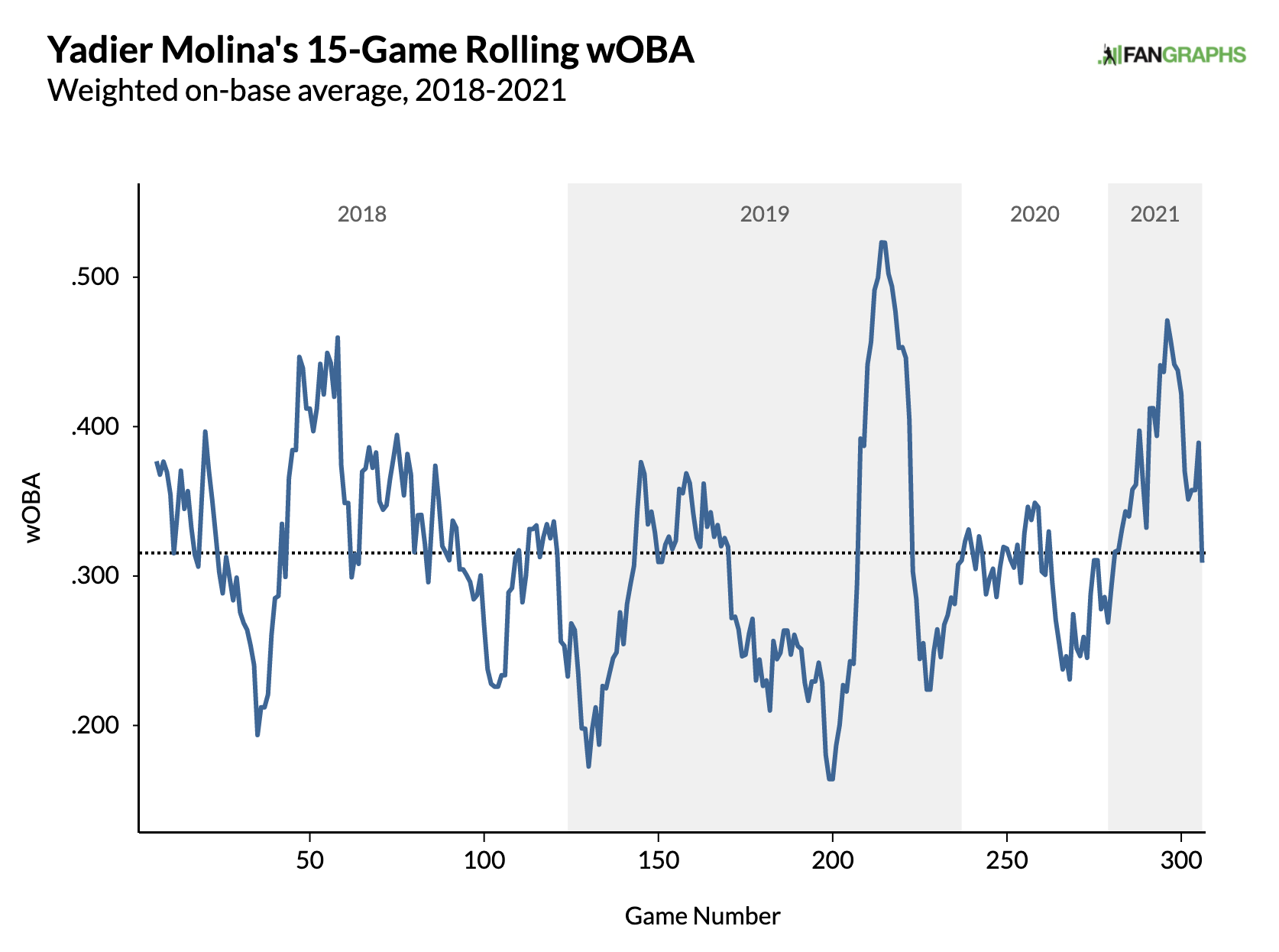
It could be because of the lingering effects of his injury, or it could be because Molina is simply cooling off. There’s no definitive answer. But it’s important to keep in mind when evaluating his offensive output. Based on the few games I’ve seen, he hasn’t gone back to his original mechanics post-injury, so that’s a non-factor. The new Molina is likely here to stay.
Is the trade-off between contact and power worth it? I think so. Molina’s skillset served him well during his prime but later produced multiple seasons of disappointing output. His exit velocities have always been decent, and supplementing them with a bit of loft should outweigh the negatives of additional strikeouts. A whiff-happy Molina is still a paragon of discipline compared to, say, Joey Gallo. Though the 138 wRC+ probably won’t last, there’s a real chance Molina is above average offensively for the first time since 2018. You wouldn’t expect Yadier Molina of all hitters to sell out power, but here we are. I’m sure the Cardinals will take it.
Justin is an undergraduate student at Washington University in St. Louis studying statistics and writing.

‘His defense is no longer an asset.’
Maybe his measurable defensive metrics including framing have declined. However, FG’s own Kevin Goldstein has time and again posited that calling a game and managing a pitching staff are highly underrated and currently unquantified aspects of a catcher’s game.
Just look at what happened to Griffin Canning against the Twins yesterday. Catcher Drew Butera called for 3 straight fastballs against Miguel Sano with the bases loaded. Sano was happy to time up that 3rd fastball and launch it into the seats.
Pitch sequencing is a shared responsibility that has a huge impact on the game. All of the credit goes to the pitcher today for throwing their pitches in a specific order to try and maximize effectiveness, but the catcher is really the one primarily responsible for pitch sequencing.
‘His defense is no longer an asset.’
But he’s on pace for something between +5-+6 in the defensive component of fWAR (am I misunderstanding? Wouldn’t this point to a positive defensive contribution?). And still, no one is running against him while he’s caught 38% of would be base-stealers this season.
I watch every Cardinals game, and there is no doubt we are not watching prime, defensive-savant Yadi. There are more passed balls, in particular. But by the eye test, he still looks pretty damn good to me. And the intimidation factor with the running game seems fully intact.
The defensive component of WAR is adjusted for position and catchers all get a large bump there which brings him from – to + when calculating WAR.
His DRS is slightly negative as is his framing. Since framing is the biggest contributor to catcher defense its safe to say his D is not what it has been this year.
Controlling the run the run game really isn’t that important in an era where no one is running all that much to begin with.
I still think if we had a good measure for game calling he’d be a top defensive C. Game calling is probably more impactful than framing. Teams certainly give it a ton of weight. How else does Mathis continue to get employed? Sandy Leon, Maldonado, etc. It’s more than just framing.
I wondered about the “intimidation factor” comment, but it appears correct. Going into today’s games, if I do my sums right, NL teams were attempting SBs about once per 13 or 14 innings, with a 75% success rate. Molina has seen 13 attempts in 233 innings, for almost exactly one per 18 innings. (His CS% is also better than league average, but that’s possibly a statistics-of-small-numbers thing.) It has been well documented that opponents have been less likely to run on him over the course of his career than most any other modern catcher. That seems intact, all right, although there’s still time for the rates to come back to league average.
Besides, while his defense has declined and his framing may no longer be an asset, I bet his blocking and throwing numbers are still above average.